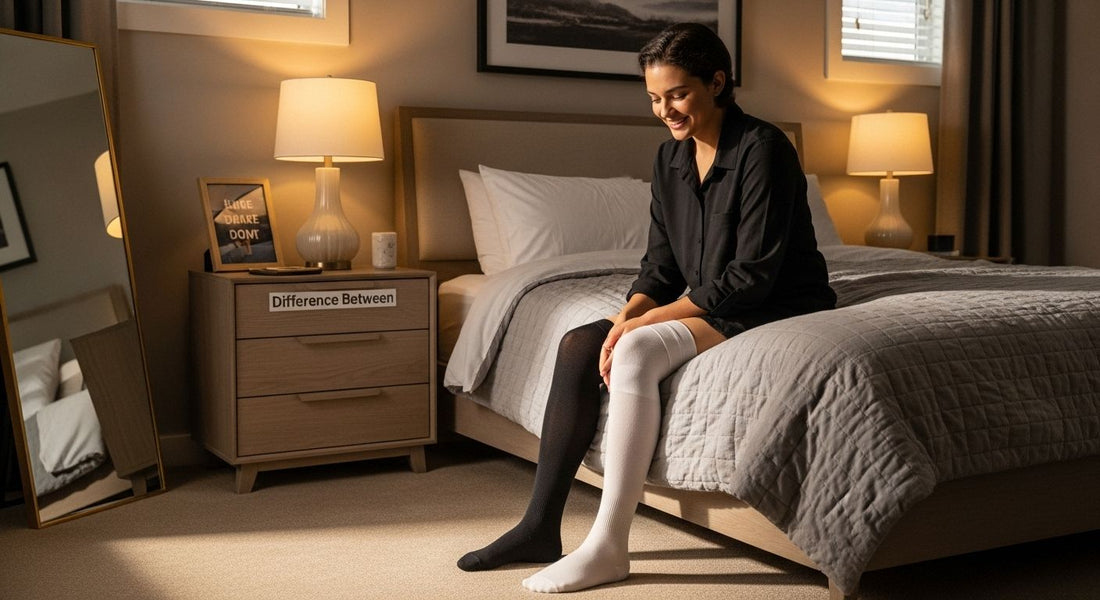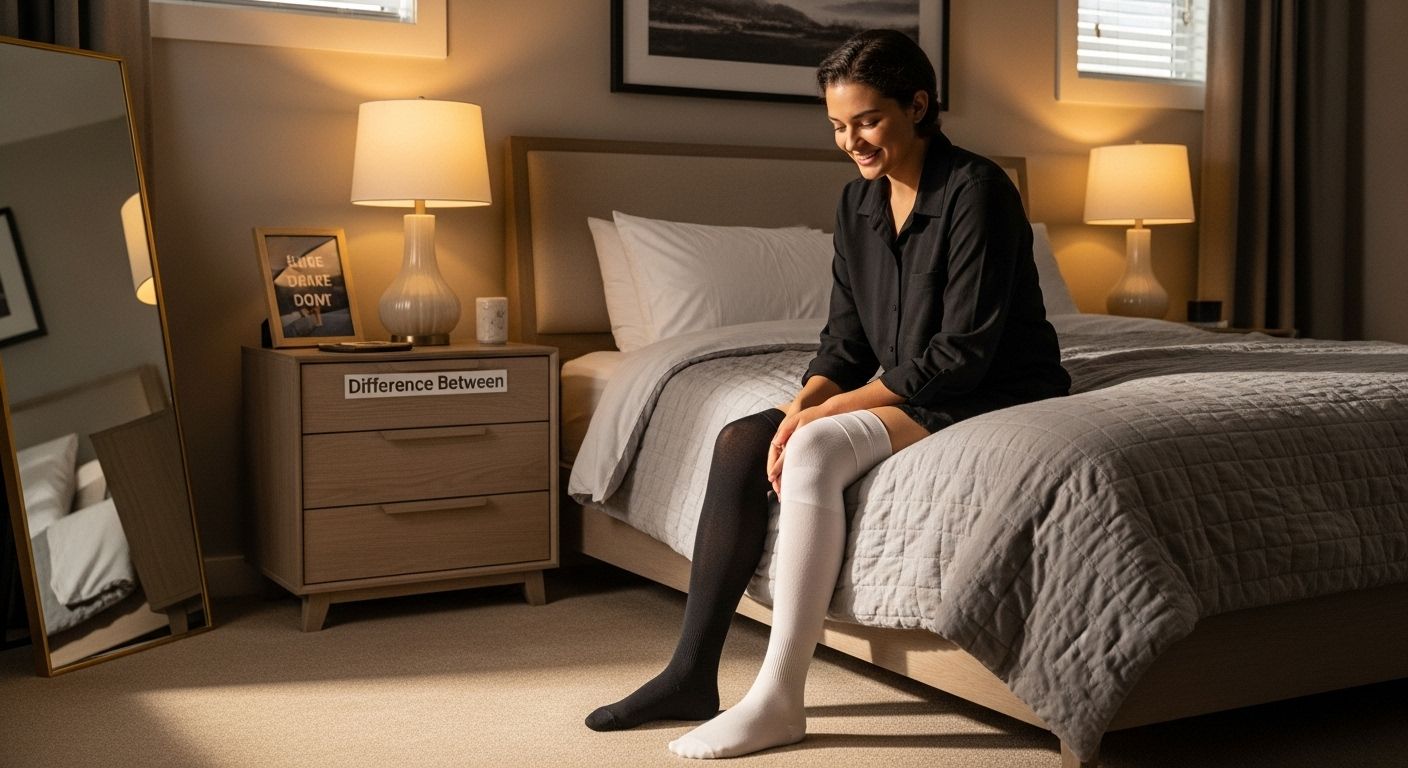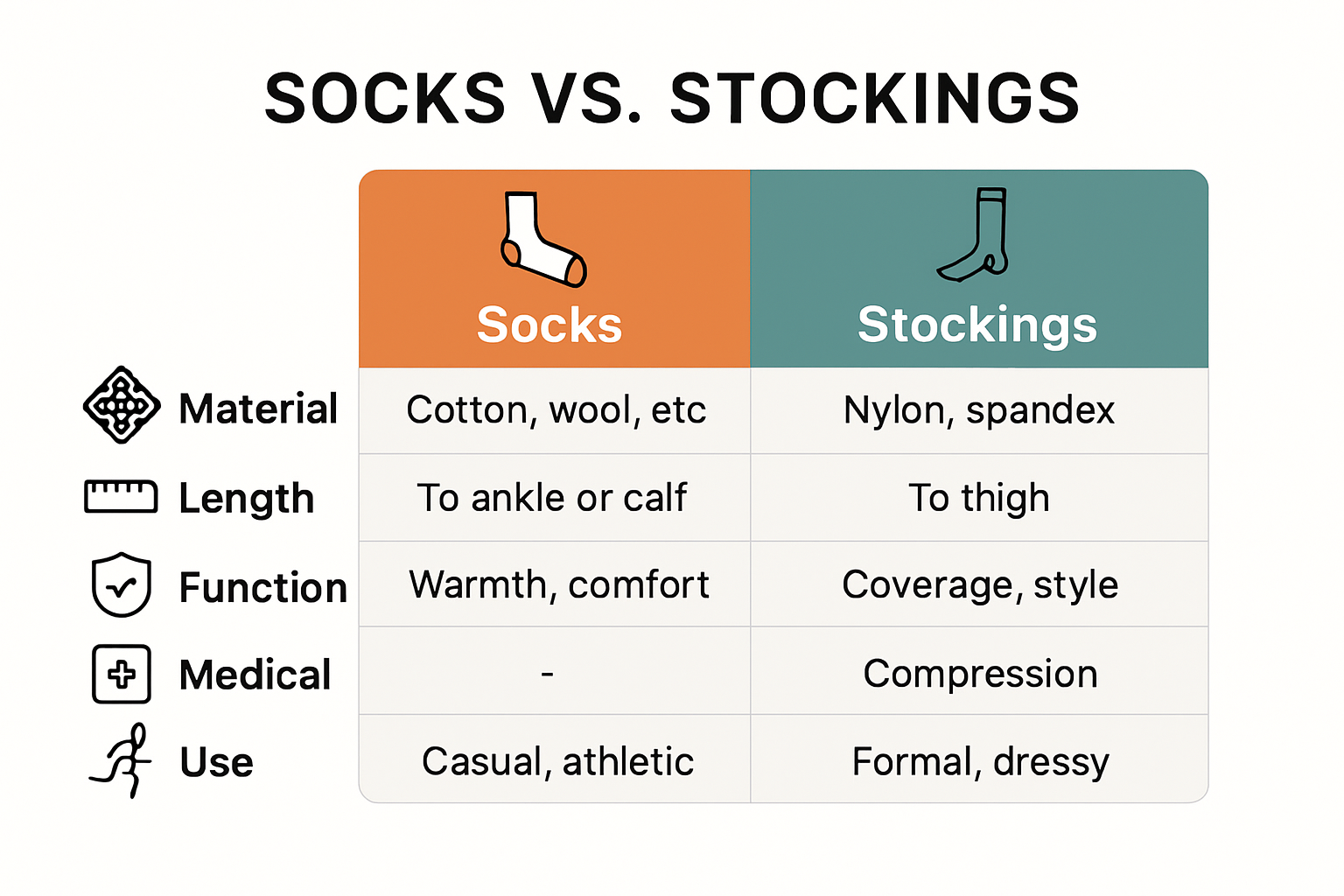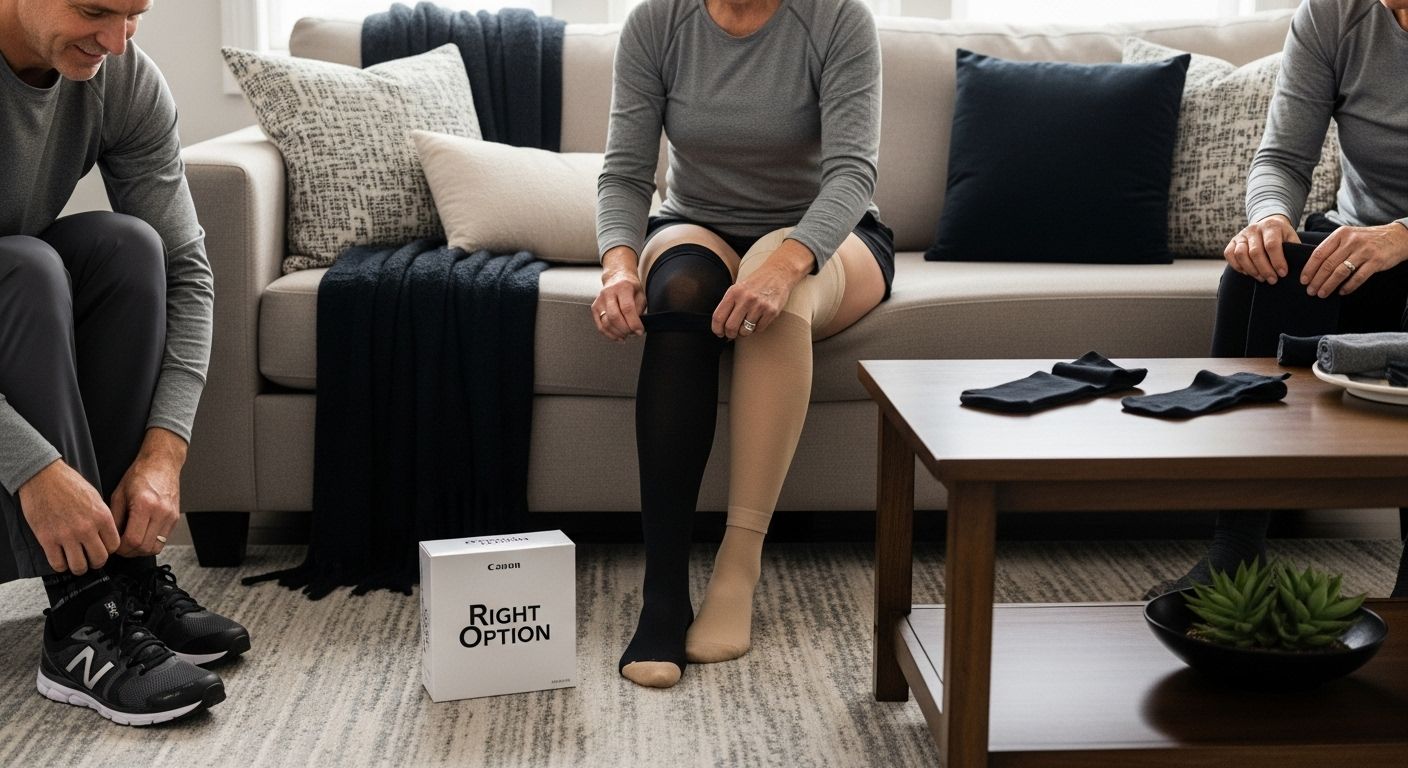
Understanding the Difference Between Socks and Stockings
Share

Most people grab a pair of socks or stockings without thinking twice. They look similar and both serve to cover your legs, right? Actually, stockings can do a lot more than just keep your feet warm. Compression stockings can improve blood flow and even help prevent serious issues like deep vein thrombosis and varicose veins. This surprising difference could change how you think about what you put on first thing in the morning.
Table of Contents
- Key Features: Socks Vs Stockings
- Health Benefits For Circulation And Support
- Choosing The Right Option For Your Needs
- Care Tips For Long-Lasting Wear
Quick Summary
| Takeaway | Explanation |
|---|---|
| Socks and stockings differ significantly. | Socks are generally for everyday comfort, while stockings provide specialized support and care for circulatory health. |
| Compression stockings enhance blood circulation. | They apply graduated pressure to promote blood flow, preventing venous issues like deep vein thrombosis and varicose veins. |
| Choosing leg wear depends on individual health needs. | Assess personal health conditions, lifestyle, and activities to determine the most appropriate type of leg wear for support. |
| Care practices extend the life of leg wear. | Proper washing, drying, and storage techniques are essential to maintain functionality and therapeutic effects of socks and stockings. |
| Consult healthcare professionals for compression needs. | Professional assessment ensures correct fit and compression level, optimizing the therapeutic benefits of compression stockings. |
Key Features: Socks vs Stockings
Understanding the key features that distinguish socks from stockings helps consumers make informed choices about their leg wear. While both serve protective and functional purposes, they differ significantly in design, material composition, and intended use.
Material and Construction Differences
Socks and stockings are crafted from distinctly different materials that determine their performance and functionality. Learn more about compression wear options to understand these nuanced differences.
Traditional socks are typically manufactured from cotton, wool, polyester, or synthetic blends. These materials prioritize comfort, moisture absorption, and breathability. According to Wikipedia, socks are designed to cover the foot and ankle, providing basic protection and temperature regulation.
Stockings, conversely, are often constructed from more delicate and stretchy materials like nylon, silk, or specialized compression fabrics. Research from medical sources indicates that medical-grade stockings are engineered with precise elastic properties to provide graduated compression, supporting venous circulation and reducing leg swelling.
Functional Purpose and Application
The functional differences between socks and stockings are profound and purpose-driven. Socks primarily serve everyday comfort needs: protecting feet from shoe friction, absorbing perspiration, and providing basic warmth. They are casual, versatile accessories suitable for various activities and footwear.
Stockings, especially compression varieties, are specialized garments with specific health and medical applications. According to medical research, compression stockings apply strategic pressure to leg veins, improving blood flow and preventing conditions like edema, deep vein thrombosis, and varicose veins. These garments are not merely fashion accessories but therapeutic tools designed to support circulatory health.
Length and Coverage Variations
Another critical distinguishing feature is the length and coverage area. Socks typically range from ankle-length to crew or knee-high styles, primarily covering the foot and lower leg. They are generally loose-fitting and prioritize comfort.
Stockings offer more extensive coverage, extending from the foot to the thigh or even waist in some medical designs. Their longer length allows for comprehensive leg support and graduated compression. Medical compression stockings are precisely measured and engineered to provide consistent pressure from the ankle upward, promoting optimal blood circulation and reducing the risk of circulatory complications.
While socks and stockings might seem similar at first glance, their underlying design philosophy, materials, and functional purposes are fundamentally different. Understanding these distinctions helps individuals select the most appropriate leg wear for their specific needs, whether for daily comfort, athletic performance, or medical support.
To help you quickly see the main differences between socks and stockings, the following table compares their key features, materials, purposes, and applications.
| Feature/Aspect | Socks | Stockings (incl. Compression) |
|---|---|---|
| Typical Materials | Cotton, wool, polyester, synthetic blends | Nylon, silk, compression fabrics |
| Main Purpose | Everyday comfort, protection, warmth | Circulatory support, medical uses, leg health |
| Coverage | Foot to ankle/knee | Foot to thigh/waist |
| Fit | Generally loose | Snug, engineered with graduated compression |
| Health/Medical Application | Minimal | Prevent DVT, varicose veins, edema, recovery |
| Care Requirements | Easy, machine-washable | Delicate, hand-washing recommended |
| Typical Users | General population | Patients, athletes, individuals needing support |

Health Benefits for Circulation and Support
Compression wear offers significant health advantages for individuals seeking improved leg circulation and physiological support. Understanding the nuanced benefits of specialized stockings versus traditional socks can help individuals make informed decisions about their leg health and wellness strategies.
Venous Health and Blood Flow Optimization
Compression stockings play a critical role in promoting optimal venous circulation. Discover advanced circulation techniques to enhance your understanding of leg health management.
According to research from the National Institutes of Health, compression stockings provide graduated pressure that actively supports blood flow dynamics. This strategic compression mechanism helps prevent blood from pooling in lower extremities, reducing the risk of venous disorders such as deep vein thrombosis and chronic venous insufficiency.
Traditional socks, while comfortable, lack the specialized pressure gradient that makes compression stockings medically effective. The targeted compression creates a physiological pump effect, encouraging blood to move upward against gravitational forces and improving overall circulatory efficiency.
Medical Applications and Therapeutic Support
Compression stockings offer extensive medical applications beyond standard sock functionality. Mayo Clinic experts highlight their effectiveness in managing various health conditions, including lymphedema, varicose veins, and post-surgical recovery.
For individuals with compromised circulatory systems, compression stockings provide critical support. Patients with diabetes, peripheral vascular disease, or those experiencing prolonged immobility can benefit significantly from these specialized garments. The graduated compression helps mitigate swelling, reduce inflammation, and support overall leg health.
Performance and Recovery Enhancement
Beyond medical applications, compression stockings have gained popularity among athletes and active individuals. Compression wear for athletic performance demonstrates how these garments can support muscle recovery and reduce exercise-induced fatigue.
Athletes and fitness enthusiasts utilize compression stockings to enhance blood circulation during and after physical activities. The strategic pressure helps reduce muscle vibration, minimize micro-trauma, and accelerate post-exercise recovery. Unlike standard socks, compression stockings provide targeted support that can potentially improve athletic performance and reduce the risk of muscle strain.
While traditional socks offer basic comfort and protection, compression stockings represent a sophisticated approach to leg health. Their scientifically designed pressure gradient provides comprehensive support for circulatory function, medical management, and physical performance. Individuals seeking advanced leg care should consider the therapeutic potential of compression stockings as a proactive health management strategy.
Choosing the Right Option for Your Needs
Selecting the appropriate leg wear requires careful consideration of individual health needs, lifestyle factors, and specific physiological requirements. Understanding the nuanced differences between socks and stockings can help individuals make informed decisions that support their personal wellness goals.
Assessing Individual Health Requirements
The selection process begins with a comprehensive evaluation of personal health conditions. Learn about personalized compression solutions to guide your decision-making process.
Research published in the National Center for Biotechnology Information demonstrates that compression stockings can significantly impact lower-leg volume and muscle fatigue. Individuals with specific medical conditions such as diabetes, varicose veins, or those experiencing prolonged standing should consider compression stockings as a potential solution.
Key factors to evaluate include existing circulatory issues, occupational demands, and potential risk factors for venous disorders. People with jobs requiring extended periods of standing or sitting can benefit from the targeted support provided by compression stockings, which offer more sophisticated circulatory assistance compared to traditional socks.
Compression Levels and Measurement Considerations
According to medical research, compression stockings are engineered with precise pressure gradients that require careful measurement and selection. Compression levels are typically measured in millimeters of mercury (mmHg), ranging from mild (15-20 mmHg) to moderate (20-30 mmHg) and high (30-40 mmHg) compression.
Professional measurement is crucial for obtaining the right fit. Incorrect sizing can lead to ineffective compression or potential discomfort. Healthcare providers or specialized fitters can help determine the appropriate compression level based on individual health needs, body measurements, and specific medical conditions.
Lifestyle and Practical Considerations
Beyond medical requirements, lifestyle factors play a significant role in choosing between socks and compression stockings. Athletes, travelers, professionals with sedentary jobs, and individuals with specific health concerns will have different requirements.
Wikipedia notes that compression stockings are designed to prevent venous disorders by applying strategic pressure to reduce vein diameter and increase blood flow velocity. This makes them particularly valuable for individuals seeking proactive health management.
Consider factors such as comfort, breathability, material composition, and intended use. Compression stockings offer more comprehensive support but may require more careful maintenance. Traditional socks provide casual comfort but lack the therapeutic benefits of graduated compression.
Ultimately, the choice between socks and compression stockings is not one-size-fits-all. Consulting with healthcare professionals, understanding personal health objectives, and carefully evaluating individual needs will guide the most appropriate selection. Whether seeking medical support, athletic performance enhancement, or everyday comfort, the right leg wear can significantly impact overall leg health and personal well-being.

Care Tips for Long-Lasting Wear
Proper maintenance of socks and compression stockings is crucial for preserving their functionality, appearance, and therapeutic effectiveness. Understanding the specific care requirements for different types of leg wear can significantly extend their lifespan and performance.
Washing and Cleaning Techniques
Discover expert washing techniques to maintain the integrity of your compression wear. Different materials and compression levels require unique cleaning approaches to prevent damage and maintain their supportive properties.
Compression stockings demand more delicate handling compared to traditional socks. Hand washing is typically recommended to preserve the elastic fibers and graduated compression properties. Use lukewarm water and mild detergents specifically designed for delicate fabrics. Avoid using bleach or fabric softeners, as these can break down the specialized elastic materials and compromise the compression gradient.
For regular socks, machine washing is generally acceptable. However, separate dark and light colors to prevent color bleeding. Use gentle cycle settings and avoid high heat, which can cause shrinkage and fabric deterioration. Wool and specialized athletic socks may require more careful treatment to maintain their moisture-wicking and shape-retention properties.
Drying and Storage Recommendations
Proper drying techniques are essential for maintaining the structural integrity of both socks and compression stockings. Air drying is the most recommended method, especially for compression wear. Lay compression stockings flat on a clean towel, reshaping them gently to preserve their original form. Avoid direct sunlight or heat sources that could damage the elastic fibers.
Standard socks can typically be tumble dried on low heat, but specialized athletic or wool socks should be air-dried to prevent shrinkage and maintain their original shape. Avoid wringing or twisting compression stockings, as this can damage their delicate elastic structure.
Storage is equally important. Store compression stockings and socks in a cool, dry place away from direct sunlight. Use drawer dividers or specialized storage containers to prevent stretching or snagging. For compression stockings, consider rolling rather than folding to maintain their shape and prevent creasing of the elastic material.
Replacement and Maintenance Guidelines
Regular inspection and timely replacement are critical for maintaining the effectiveness of both socks and compression stockings. Compression stockings typically have a shorter lifespan due to their specialized elastic properties. Most manufacturers recommend replacing them every 3-6 months, depending on frequency of use and care.
Look for signs of wear such as loss of elasticity, thinning fabric, or visible stretching. These indicators suggest that the garment is no longer providing optimal support or compression. For compression stockings, reduced effectiveness can compromise their therapeutic benefits.
Traditional socks generally last longer but should still be replaced when they show signs of significant wear, such as holes, thinning fabric, or loss of elasticity at the cuffs. Athletic and specialized socks may have shorter lifespans depending on their intended use and intensity of activity.
Caring for your leg wear is an investment in both comfort and health. By following these specialized care techniques, you can maximize the performance, durability, and therapeutic benefits of your socks and compression stockings. Remember that proper maintenance not only extends the life of these garments but also ensures they continue to provide the support and protection your legs need.
Proper care is essential for both socks and compression stockings to extend their functional lifespan. The table below outlines the key care steps and considerations for each type of leg wear.
| Care Aspect | Socks | Compression Stockings |
|---|---|---|
| Washing | Machine-washable, gentle cycle | Hand-wash in lukewarm water |
| Detergent | Regular or mild | Mild, no bleach or softeners |
| Drying | Tumble dry low or air dry | Air dry flat (no sunlight/heat) |
| Storage | Drawer or container, folded | Cool/dry place, rolled, avoid creasing |
| Typical Replacement | When holes/thinning/loss of stretch | Every 3-6 months or when elasticity fades |
Frequently Asked Questions
What is the main difference between socks and stockings?
Socks are generally designed for everyday comfort, offering warmth and protection for the feet and lower legs. In contrast, stockings, especially compression varieties, are engineered to provide specialized support for circulatory health and venous issues.
How do compression stockings benefit circulation?
Compression stockings apply graduated pressure to the legs, promoting blood flow and preventing conditions like deep vein thrombosis (DVT) and varicose veins. This pressure helps to improve venous return and reduce leg swelling.
Can I wear compression stockings all day?
Yes, compression stockings can be worn throughout the day. However, it’s important to consult a healthcare professional regarding the duration and compression level based on individual health needs and lifestyle.
What should I consider when choosing between socks and stockings?
When choosing between socks and stockings, assess your individual health requirements, lifestyle factors, and activities. Compression stockings may be beneficial for those with circulatory issues, while standard socks offer comfort for general wear.
Experience Real Support With Medical-Grade Compression Stockings
Now that you understand how stockings can offer advanced leg health solutions far beyond what everyday socks provide, it is time to take control of your circulation and comfort. If you face problems like tired, aching legs, varicose veins, or swelling, regular socks just cannot offer the targeted support your body needs. True difference comes from choosing quality compression stockings designed for your health objectives. By reading about graduated compression, medical applications, and correct sizing in this article, you are already on the path to better leg health.
Take the next step by exploring our carefully selected Waist High (Pantyhose) for full-leg relief or discover trusted brands like Jobst for trusted, clinically-backed solutions. Shop confidently at Fit Stockings, where you get expert guidance, free shipping, and easy returns. Do not wait for leg discomfort to become worse. Find your ideal compression stockings today and feel the difference with every step.

